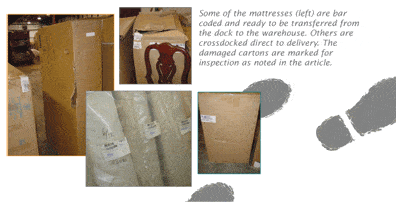Checklist of policies and procedures that ensure accurate inventory counts, reduce theft and boost employee productivity.
Warehouse & Delivery By Dan Bolger, P.E.
High Performance Retailers achieve inventory accuracy by investing the same degree of careful attention in their inventory processes as they do to posting to sales, payroll and cash. This assures that their inventory counts are accurate and there aren’t any surprises when merchandise is pulled for delivery or when inventory numbers are verified for a bank or auditors. Process excellence also results in labor productivity gains, fewer hassles and makes the inventory available more quickly for sales or delivery.
Accurate inventory counts are the result of carefully tracking merchandise from suppliers, transfers to/from showrooms, deliveries, customer returns or exchanges and handling damaged merchandise. To do this right it is necessary to follow standard procedures and leave an easy to follow audit trail. Failure to do all of the above provides opportunities for employee dishonesty, fraud and financial losses that could put you out of business. It happens in our industry all the time.

As you evaluate internal processes, note how you might gain efficiency by eliminating steps and reducing chances for errors. From a process standpoint, imagine that a high fence surrounds your warehouse. Nothing gets in or out unless it is logged at each gate.
STEP #1: ADVANCE INFORMATION
Collect & Use Information: High performance retailers know exactly what goods are due to arrive and when they are due. This information may come from direct access into suppliers’ computers, Advance Shipping Notifications (ASN), faxes or emails. If they use a carrier consolidation program, the details may come from the carrier. Smart collection and use of this information gives them an opportunity to speed customer service. That’s because they can determine, in advance, if products can simply be staged for same or next day delivery, directly moved to the showroom, or stored for an expected customer delivery date.
STEP #2: IN-TRANSIT SECURITY
Check Security Seals: If you are getting a full truckload, trailer doors should be sealed with numbered security seals. Compare the actual number on the seal to the bill of lading and have your employee break the seal. If the trailer has side doors, they must be checked too. Don't let the truck driver break the seal and bring it into the office. One of the oldest theft tricks is to break into a trailer, steal merchandise, and then reseal the trailer with another seal stolen from the shipper. If seal numbers don't match, beware and call the vendor.
Secure The Vehicle: Secure the vehicle before unloading with chocks or other devices. Confirm that safety measures are taken before entering the truck. Provide adequate lighting so employees can see what they are doing.
STEP #3: COUNT & INSPECT
Ready Receiving Labels: Assuming you aren’t one of the limited number of retailers that receive stock with pre-applied bar code labels that your system can handle, the labels for receiving should already be in the hands of the receiving crew when the truck is backed into the dock. Your system should prepare multiple labels for sku’s that are in multiple cartons, identifying carton 1 of 3, 2 of 3, etc. Whether you use serialization or not is a decision that needs to be based on the products you are handling, their finish or fabric matches.

Damage Check: Count and inspect merchandise carefully, paying special attention to products susceptible to damage. Certain vendors are notorious for poor packaging and these packages must get extra care. Look for cartons that are damaged, crushed or punctured. Be sure to carefully inspect the bottom several inches of case good cartons for holes caused by lift truck forks. You may apply bar code labels as they come off the truck or in the receiving lane; matching the label to the carton item description.
Shake cartons containing glass and listen for broken glass noise. If there is damage, it must be noted on the driver's copy of the paperwork as well as yours. A digital camera should be available on the dock to document badly loaded trailers (Did they load it with a cannon?) and damaged product. Save cartoning materials with the product for possible inspection or return to the vendor.
Organization: Organizing merchandise for ease of reconciliation and storage speeds the job. Receive everything to a dock lane location which should be cleared daily.
Start The Audit Trail: Counting requires absolute accuracy. Many retailers check off from the carrier's packing list as a tally and return any excess labels to the office. The receiving tally is the start of the audit trail. This document must contain the required information plus any exceptions such as overages, shortages and damage recorded in detail. Always count twice before signing once! Set up a digital image filing method to document photos that will accompany damage claims.
STEP #4: STORAGE
Move It Out: The next step is to transfer the goods from the dock location. A staging area for merchandise that can go directly to customers without storage can be a real money saver. Best performers are calling customers to arrange delivery of complete orders within hours of receipt. Move damaged material to a repair area. Running a dock report when the dock is cleared is a quick check that all transfers from the dock have been done.

STEP #5: CUSTOMER RETURNS AND INVENTORY TRANSFERS
Return Policies: Customer returns can be a real challenge. Care must be taken to assure that the return is in accord with your policies and that the product hasn't been abused or have missing parts. This can be an opportunity to build on a good relationship, but there are also situations when refusal is appropriate. Do you have simple and clear instructions outlining how your people should handle returns? Are decisions made in a timely manner?
Label For Easy ID: You must be absolutely sure that all items going back into inventory are new and in new condition. A recommended practice is to put a green plastic wrap around acceptable items, a yellow wrap on items needing repair, and red on non-saleable items. Some items may be repaired and designated for clearance. Bar code labels need to be prepared in accord with your system requirements.
The processes for returning “Not at Home” stock and transfers from store inventory to stock are identical.
STEP #6: PULLING STOCK
Count Your Steps: You need to decide how many scans to do between the warehouse location and final delivery. Some retailers scan at each of the following transfer steps while others skip some steps. The decision should be based on the complexity and size of your warehouse.
- Warehouse location to lift truck or cart.
- Lift truck to shipping dock lane, shop, showroom entrance, etc.
- Assembly and deluxing completed.
- Scan into the delivery truck or store location.
Most systems remove stock from inventory after the sales order is closed out.
STEP #7: CYCLE COUNTING & INVENTORY TAKING
Check Your Intervals: While following steps 1 through 6 above will assure a high degree of inventory accuracy, it is essential to routinely verify stock location accuracy. Cycle counting may be accomplished weekly to monthly. A complete inventory should be taken at six to twelve month intervals unless there has been a significant inventory variance in the previous period.
Look Out For Waste: There are furniture store operations where ten to twenty percent of warehouse labor time is spent looking for inventory. In addition to these direct labor costs, management time is lost chasing inventory problems and in following up with customers who receive less than perfect service. Accomplishing the details of these seven steps will improve your profitability, reduce non productive efforts and definitely improve customer satisfaction.
Daniel Bolger, P.E. provides operations consulting services to clients throughout North America. You can contact Dan at bolger@furninfo.com for more information on this or other transportation, logistics and furniture warehousing topics. Go to www.furninfo.com to read all of Dan’s articles on transportation, logistics and warehousing.